Painting chairs and benches is labor-intensive work! Chairs and benches that have turned spindles with a ton of grooves is even more so. Most paints require a separate primer to be used first and those that don’t require three or more coats for full coverage and then a clear topcoat to protect the finish. Uuuggghh! We want fewer steps! We want a paint that will adhere! We want a paint that will harden beyond belief and be its own topcoat! So what is the best paint for chairs and benches?
If you’re painting furniture, you’ll want to work efficiently. That means working smarter not harder. Choosing the right paint from the beginning for whatever piece of furniture you’re working on is important. Today, we’re specifically talking about chairs and benches.
Now, let me insert a quick note here and say that I do believe that a stain/polyurethane combination finish is preferred for chairs and benches because it’s the most durable finish you can achieve. You’ll see how I do this with some kids tables and chairs I’ll be posting later this week. But, often times, re-staining is not an option or a custom color paint is just preferred.
So let’s get to it.
.
The Best Paint for Chairs & Benches
After many years of refinishing furniture, I’ve found that the best paints for chairs and benches are oil based paints. Oil-based paints are extremely durable. However, oil-based paints can also cause more irritation to eyes and airways than water-based paints and be much more difficult to clean up because they require even more chemicals to clean the brushes.
For these reasons and because I paint so much, I prefer to work with water-based paints.
The best water-based paint for chairs and benches is clearly acrylic enamel, specifically two lines of paint by Benjamin Moore that I use most often. Both of these paints
- adhere extremely well
- do not require priming
- provide excellent coverage
- dry within just over an hour
- do not require a topcoat
- harden within a day
.
.
To see the the exact brand and type of acrylic enamel paint I use, please refer to this ebook, Painting Furniture.
Here, I explain all of the different types of paints, including my go-to paints for each type of project. I also explain how to manipulate the paint to minimize brush marks.
.
.
Prepping Chairs & Benches for Painting
Chairs and benches come in all shapes and sizes, but one thing they all have in common is that they have multiple small spindles or slats that make up the arms, legs, and back, making prepping and painting tedius work. Almost all of them are also coated with polyurethane that either needs deglossing or sanding – specifically sanding by hand.
I’ve tried Chalk paint on chairs several times. Chalk paint brands claim their paint will stick to any surface, even that shiny polyurethane; but bang into it once and you’ll find that Chalk paint to knick really easily. That’s not a good option for chairs that are constantly being slid in and out at the dinner table and knocked against one another. You could add a layer of polyurethane to harden the surface, but that’s an added step – and when you’re refinishing a set of 6 or 8 chairs, it’s time-consuming.
Milk Paint and Latex paints are a better option for chairs and benches but still not my favorite option. With either of these, you have to properly prep the surface, prime, and in most cases add a protective topcoat. If you choose a semi-gloss or gloss paint finish thinking you’ll have the topcoat built in, think again! Semi-gloss and gloss latex paints take up to 60 days to fully cure. Even after waiting the 60 days, I’ve still had semi-gloss paint pull off of furniture when something is set down on top of it.
The enamel is a much better option that will save you a ton of time because of their ability to adhere, their coverage, and the fact that you don’t need an extra topcoat.
For example…
Here’s a stained/polyurethaned bench that a client asked me to paint black. The first thing I did was sand with my DeWalt rotary sander with a 60-grit sanding disc to remove as much of the old polyurethane from the flat surfaces as I could.
Even after the electric sanding though, much of the poly remained in the grooves on and around the spindles so I quickly hand-sanded each spindle with 60-grit sandpaper.
Some chairs I’ve even gotten really lazy with and barely sanded them at all. My point is the enamel paints I use still adhere to the shiny poly that’s not able to be removed.
If you despise sanding, liquid deglossers like THESE are an option. Simply wipe them on and they’re supposed to degloss that shiny clear coat. The only deglosser I’ve used myself is Velvet Finishes Ready and these enamel paints adhered perfectly after using it.
.
Applying Paint to Chairs & Benches
The enamel paint I use sticks to all types of surfaces, including wood and metal. I used it on these dining chairs, these captains chairs, and these lemon ombre chairs all with great success.
When I first started using this paint, I used the low-lustre finish which is almost identical to the smooth satin finish you find on black painted furniture from Pottery Barn.
Now I actually prefer the semi-gloss finish although this can be more difficult to find in the quart sizes lately.
The higher gloss version is similar. Neither require priming first, saving you that added step.
If you plan to paint a chair that originally had a dark or reddish stain with a light color paint like white, I do recommend first using a BIN primer. BIN is a shellac primer that blocks bleed through unlike any other primer I’ve found and worth the added step if you’re painting with white. So do not skip this!
Here’s a table and set of chairs that was primed with BIN primer then painted with the Ultra Spec DTM enamel.
And below is the bench painted in the high gloss Impervex.
No matter the sheen level, these paints result in a smooth surface. And the best part is that they’re enamel paints that harden within hours, not weeks or months, of application. You can actually begin using the painted furniture right away. The surface hardens as if you applied a heavy coat of polyurethane so there’s no need for an additional topcoat.
Safety Gear
Remember to paint in very well-ventilated areas (preferably outside or with my garage door fully open) and wear safety gloves, and splash goggles. I also wear a respirator mask rated with the highest P100 rating.
Perhaps it’s time to give your own dated furniture a second life. Then, add a small side table in the same refinish to give it even more notice. Your entryway will be both practical and feel cohesive with two useful items.
.
Did you find this article helpful? I’d love it if you shared these two pins:
Disclosure: This post contains affiliate links to products I use myself.

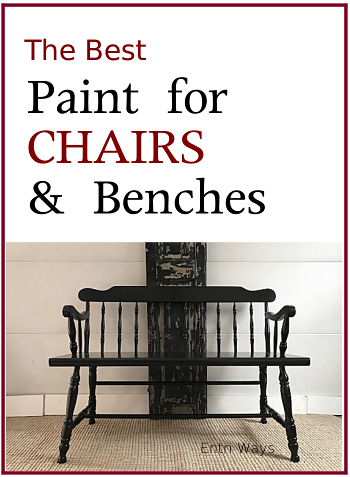
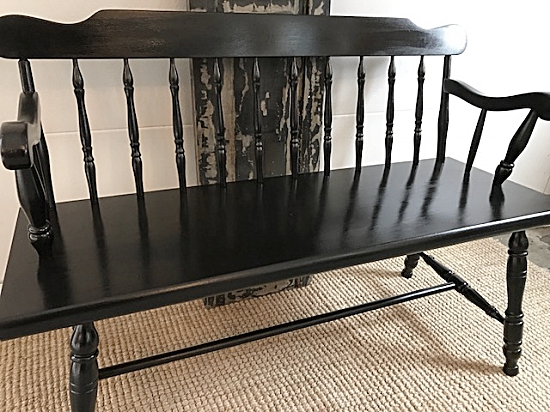
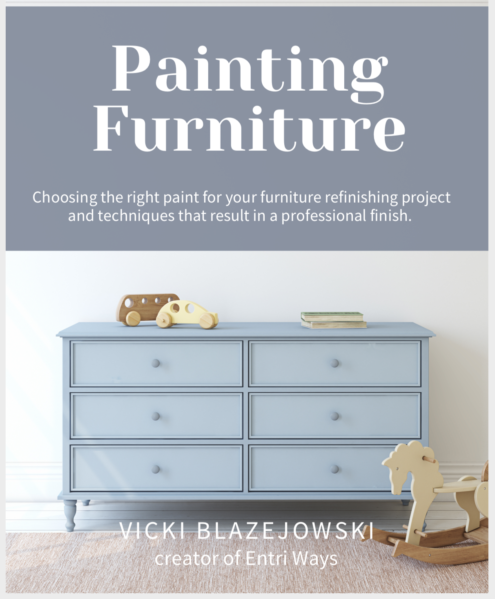


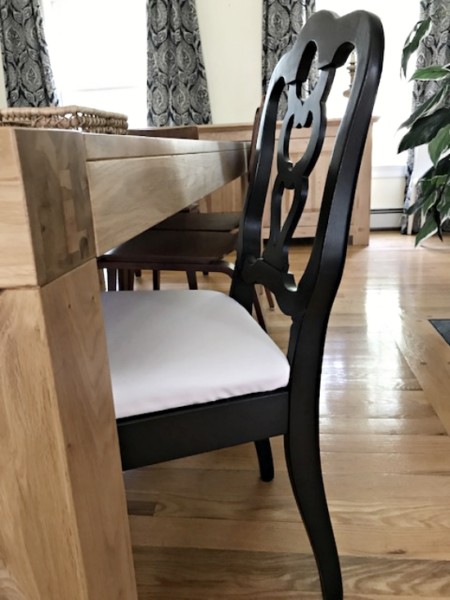
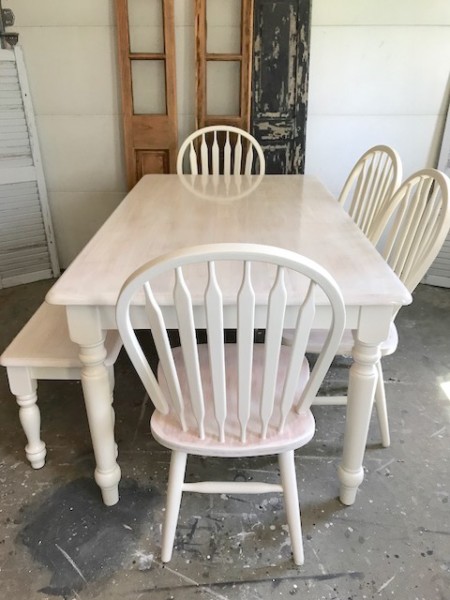



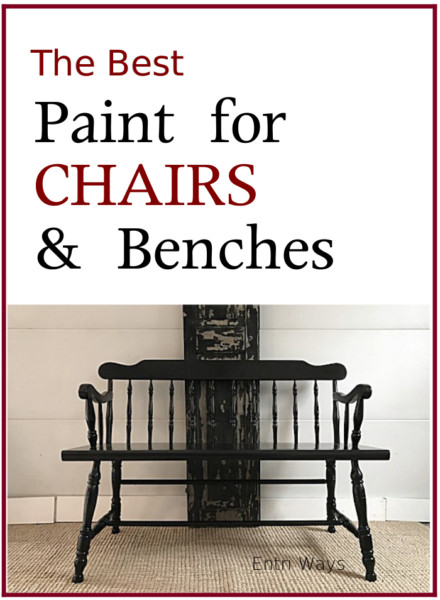

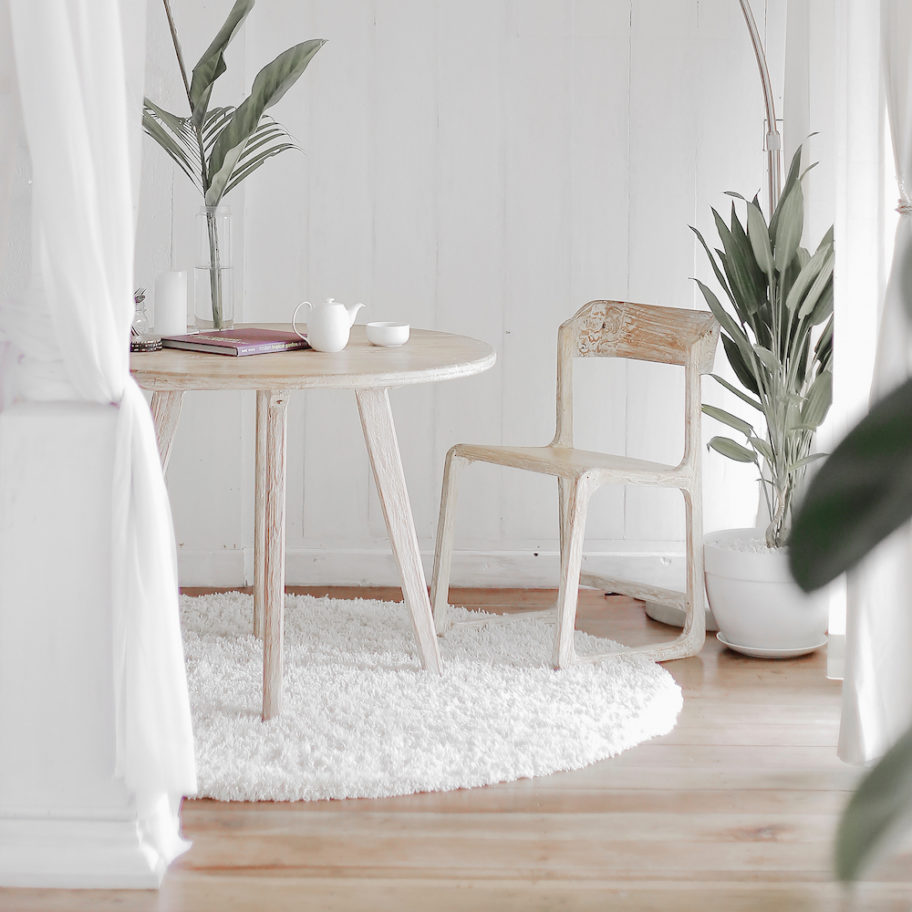

did you spray the bench? If you brushed it how did you get rid of the brush marks?
I use a brush to apply all of my paints. I use a very trim Purdy brush which you can find here: https://amzn.to/2M5SJyA (affiliate link). And thank you for the compliment that you cannot see any brush marks. There are some if you look very closely.
To minimize brush marks be sure to use a very good brush like the Purdy and if needed, you can thin the final coat of latex paint with a little water. Hope that helps.
If the BM ULTRASPEC is not quite glossy enough, can I topcoat it with a semigloss clear coat? I really didn’t want high gloss, but something between satin and semi gloss.
Patti
Yes Patti. You can paint a water-based clear coat on top of the water-based UltraSpec. Satin should give you plenty of shine. Gloss would be really glossy.
Hi I am painting my every day kitchen chairs. I was going to use Fusion Paint but have Valspar satin based latex premium enamel paint in black oh hand. Thoughts on what you are suggesting versus one of these choices. Thank you.
Melis, I haven’t used either of these on furniture so wouldn’t be able to testify as to their performance. I have used Valspar’s oil based paint and Valspar’s Cabinet Enamel and both work really well on furniture and have excellent durability because they harden much more so than a latex paint. As you read in this article though, my go-to paint for chairs is Benjamin Moore’s DTM enamel. I’ve found the oil based, low-lustre DTM to be outstanding and gives you that perfect Pottery Barn finish, but because I paint so often I stick with the water-based version which is my second favorite. Hope that helps.
I’m just starting a little DIY project, resurfacing a foyer bench. I noticed the paint was specific for direct to metal? So being they’re wood/laminate you feel BM and primer since I want white finish?
Rachel, Yes, if you’d like the final finish to be white, a stain-blocking primer is recommended. My preferred primer when painting with white is BIN primer, a shellac-based primer. Be sure to use in a well-ventilated and use caution because it’s a very thin primer that splashes quite a bit, but well worth the finished result.
I’m building a breakfast nook in my 1-bedroom apartment. Primed it will KILLZ and and want it painted white, pure, plain, unadulterated white. The seat and seat back are already attached to the wall.
Using the Benjamin Moore’s Ultra Spec DTM low lustre, how long before I can put anything on it? Also, since this is right next to my kitchen and cooking area and living room, is that going to be a problem with “dust” ? I don’t have any pets and live in Denver, CO where the humidity is low. I can ventilate by opening my front door and porch doors which are no more than 15-20 feet away.
Any suggestions? Oil vs. Water based DTM?
Dan
Thank you for contacting Entri Ways.
Primer: Since the wood you used to build the bench was most likely natural wood that never had any finish on it prior, then the Kilz primer should be fine. However, I would wait at least 3 days to see if there is any bleed before attempting to paint. When painting with white, I always use BIN primer. It’s a shellac based primer I’ve found to be best at preventing bleed.
Paint: I really like like Benjamin Moore’s DTM Low Lustre paint. The finish from an oil-based paint is really nice. But I use the water-based version.
A few tips… You can water the paint down a bit for a much smoother finish. Apply thin coats. This acrylic enamel dries and hardens very quickly and much faster than latex. I always tell people you can feel comfortable using it after a few days or maybe a week, but allow it to fully cure for the first 30 days.
You asked about “dust” but then I thought you may be referring to fumes. I always paint in a well-ventilated area (a garage where there’s lots of airflow. A few years ago I compared the VOC level to that of other paints and found it to be much lower than even typical “contractor’s choice” wall paint.
Regarding “dust” that may land on the furniture… As with any paint, the higher the sheen, the easier it is to wipe away any dust that’s accumulated on top. If you were painting with a dark color, I would encourage you to mix a little of the Impervex Gloss paint with the Low Luste for more of a sheen because without it you will get dust marks on the dark color. But if you’re painting with white, dust marks are less of an issue. If you find dust marks to be an issue (run your hand over the surface and if it leaves chalk-like marks you’ll know), then either mix in the higher gloss paint or add a coat of low lustre water-based poly (Benjamin Moore Stays Clear is my favorite).
Hope that answers your questions. Would love if you shared a photo of your finished product on our facebook page.
Vicki
Entri Ways
EntriWays.com
P.S. These are our own opinions and experiences with these products. Different products can react differently depending on the furniture. For official information, refer to the manufacturer’s data.
I have a newly made, primed & painted bench in white. It was just a plain semi gloss interior white paint that was used, with no top coat, so I don’t think it will stand up to normal use. I had thought of using a clear topcoat, but am worried about yellowing. Can I sand lightly & apply a coat of the Ultra Spec DTM low lustre to get a more durable finish? TIA for any help!
Jan, yes you could very lightly sand just to create a little “tooth” for the new paint to stick to then apply the DTM paint. But I really don’t think you need to worry about this now. If the bench was painted 60 days or more ago and has had time to cure, the finish should last you quite some time. Next time it’s ready to be cleaned up (and that may be a few years depending on use), consider using the DTM paint. Or Valspar makes a great Cabinet Enamel that works just as well as the DTM (I discovered the Valspar Cabinet Enamel after I wrote this post). They are both great enamel paints. Before I discovered these enamel paints, and on the rare ocassion I used a latex paint on furniture, I would apply a clear water-based topcoat. Early on Minwax Polycrylic was what I used and it worked fine. Today my preference is Benjamin Moore’s Stays Clear. Their low lustre version will give you plenty of sheen.
Thank you! Bench was just painted a few days ago & my daughter wants to start using it right away, so I think I’ll go ahead & apply a coat of the Valspar Cabinet Enamel or the DTM since you mention that it will harden within a day.
Jan, just be sure to test a small area where you applied the latex paint to ensure the latex adhered well to begin with.
Beautiful outcome on these pieces! Did you apply the paint with a brush or a sprayer?
Thank you Leslie. I always use a brush. I don’t have the space to set up a spray booth. I tried a sprayer without a booth and you really need a dedicated booth.
This is a DTM(direct to metal paint). Have you any issues painting wood?
Not so far Shirley.
Hi. I can’t seem to find this paint anywhere. I’m trying to find a good paint for my daughter’s wood bed. Thank you
Only certain Benjamin Moore retailers carry the DTM. Another great alternative is Valspar’s cabinet enamel. You can find it at Lowes.
I am in the process of letting my chairs with DMT paint cure. Did you use any finish on top of the paint? I am slightly worried because after the second coat when I rubbed my hand over the finish two days after painting, it left streaks. I did the third coat and am letting the paint cure for two weeks per Benj. Moore’s CS. If you used a finish, what was it?
If you’re getting what looks like gray chalk marks over a black finish it could be because you used a low-sheen product. But you mention in your other note that you used the oil based DTM so you should not need a top coat. Yes, sometimes when I use the water-based low-lustre DTM, I need to add a clear-coat over a dark color paint.
Hi again, I just read some of your letters and replies and felt I should tell you I used the Alkyd DTM paint. I was not aware that it comes in a water-based version. Did I understand correctly that you use the water-based?
Diane, The first set of chairs I ever painted was with the oil-based DTM alkyd and they came out beautiful – just like a set from Pottery Barn. Since I paint so much I switched to the water-based products.
Just want to say “thank you” so very much for sharing your information. We just got a great deal on dark brown dining chairs which we will be painting white. They are somewhat glossy, so please correct me, but are you saying this:
To sand ( well or was it lightly?)
Then carefully use that very liquidy primer,I think you said Bin.
Then paint with good brushes with the oil based Bengimine moore DTM in white.
Let dry then paint second coat ( or was it 3 coats) ?
Did I miss steps or get this wrong?
.
Linda, If I were refinishing these glossy brown chairs, I would sand them. The more you sand the better. I use a rotary sander on as much of the chairs as a I can, then hand-sand. Apply at 2 coats of BIN. Since you’re painting white, you may need a 3rd coat of the DTM to cover the brown. Oil is best, but I use the water-based and it works well. Here’s a post where I painted mahogany chairs white: https://entriways.com/refinish-furniture-for-your-college-student/
What about Benjamin Moore advanced? Is it a good finish for benches?
The Advance paint does not harden as quickly or as well as an enamel so it’s not my first choice for chairs and benches.
Hi, I have been looking for the Benjamin Moore DTM paint in low luster, it does not seem to be available. Semi-gloss is available but I really want the Pottery Barn finish on a dining table and chairs project. These pieces will see a wear.
What are your thoughts?
Carmella, Not all BM retailers carry the DTM low lustre, but may be able to order it for you. I’ve actually been using the semi-gloss more often and am very happy with it. I actually prefer the semi-gloss now. A few options: The water-based semi-gloss should be fine and give you the look you want. Or, you could try the oil-based version in low lustre. The oil-based is actual the one I first used (by accident) and how I discovered the DTM paint.
What color black did you use.would this be good for a banister.Also is this Benjamin Moore advance paint.
Thanks
The Benjamin Moore DTM acrylic enamel paint comes in a pre-mixed black which I used on this bench. But you can have it mixed in any color you’d like.
On the bench with spindles, you used the high lustre?
Yes, I used the high gloss on this one. The semi-gloss would be great too. Both are very durable and have some shine.
Can this be used on top of chalk paint (not the kind you use chalk on)
Thank you in advance.
Most chalk paint is finished with a clear wax. Paint will not adhere to wax. This post may help: https://entriways.com/how-to-paint-waxed-furniture/
Would I be able to use this paint for kitchen cabinets?
I used it on my bathroom vanity cabinet. You can see it here: https://entriways.com/how-to-quickly-paint-a-bathroom-vanity-cabinet/